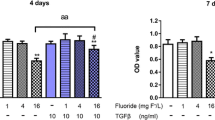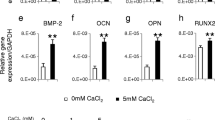Abstract
Osteoblast L-type voltage-dependent calcium channels (VDCC) play important roles in maintaining intracellular homeostasis and influencing multiple cellular processes. In particular, they contribute to the activities and functions of osteoblasts (OBs). In order to study how L-type VDCC modulate calcium ion (Ca2+) homeostasis and the expression of osteogenic transcription factors in OBs exposed to fluoride, MC3T3-E1 cells were exposed to a gradient of concentrations of fluoride (0, 2.0, 5.0, 10.0 mg/L) in combination with 10 μM nifedipine, a specific inhibitor of VDCC, for 48 h. We examined messenger RNA (mRNA) and protein levels of Cav1.2, the main subunit of VDCC, and c-fos, c-jun, runt-related transcription factor 2 (Runx2), osterix (OSX), and intracellular free Ca2+ ([Ca2+]i) concentrations in MC3T3-E1 cells. Our results showed that [Ca2+]i levels increased in a dose-dependent manner with increase in concentration of fluoride. Meantime, results indicated that lower concentrations of fluoride (less than 5 mg/L, especially 2 mg/L) can lead to high expression of Cav1.2 and enhance osteogenic function, while high concentration of fluoride (10 mg/L) can induce decreased Cav1.2 and osteogenic transcriptional factors in MC3T3E1 cells exposed to fluoride. However, the levels of [Ca2+]i, Cav1.2, c-fos, c-jun, Runx2, and OSX induced by fluoride were significantly altered and even reversed in the presence of nifedipine. These results demonstrate that L-type calcium channels play a crucial role in Ca2+ homeostasis and they affect the expression of osteogenic transcription factors in fluoride-treated osteoblasts.



Similar content being viewed by others
References
Gutowska I, Baranowska-Bosiacka I, Siennicka A et al (2012) Activation of phospholipase A (2) by low levels of fluoride in THP1 macrophages via altered Ca(2+) and cAMP concentration. Prostaglandins Leukot Essent Fat Acids 86:99–105
Xu Z, Xu B, Xia T et al (2013) Relationship between intracellular Ca2+ and ROS during fluoride-induced injury in SH-SY5Y cells. Environ Toxicol 28:307–312
Kubota K, Lee DH, Tsuchiya M et al (2005) Fluoride induces endoplasmic reticulum stress in ameloblasts responsible for dental enamel formation. J Biol Chem 280:23194–23202
Liu WH, Kao PH, Chiou YL et al (2009) Catalytic activity-independent pathway is involved in phospholipases A2-induced apoptotic death of human leukemia U937 cells via Ca2+-mediated p38 MAPK activation and mitochondrial depolarization. Toxicol Lett 185:102–109
Akpinar A, Uğuz AC, Nazıroğlu M (2014) Agomelatine and duloxetine synergistically modulates apoptotic pathway by inhibiting oxidative stress triggered intracellular calcium entry in neuronal PC12 cells: role of TRPM2 and voltage-gated calcium channels. J Membr Biol 247:451–459
Nazıroğlu M, Sahin M, Cig B et al (2011) TRPM2 channel membrane currents in primary rat megakaryocytes were activated by the agonist ADP-ribose but not oxidative stress. J Membr Biol 241:51–57
Naziroğlu M, Uğuz AC, Ismailoğlu Ö et al (2013) Role of TRPM2 cation channels in dorsal root ganglion of rats after experimental spinal cord injury. Muscle Nerve 48:945–950
Barry EL, Gesek FA, Yu AS et al (1998) Distinct calcium channel isoforms mediate parathyroid hormone and chlorothiazide-stimulated calcium entry in transporting epithelial cells. J Membr Biol 161:55–64
Bergh JJ, Shao Y, Puente E et al (2006) Osteoblast Ca2+ permeability and voltage-sensitive Ca2+ channel expression is temporally regulated by 1, 25-dihy-droxyvitamin D3. Am J Physiol Cell Physiol 290:C822–C831
Bergh JJ, Shao Y, Akanbi K et al (2003) Rodent osteoblastic cells express voltage-sensitive calcium channels lacking a gamma subunit. Calcif Tissue Int 73:502–510
Duncan RL, Akanbi KA, Farach-Carson MC (1998) Calcium signals and calcium channels in osteoblastic cells. Semin Nephrol 18:178–190
Catterall WA (2000) Structure and regulation of voltage-gated Ca2+ channels. Annu Rev Cell Dev Biol 16:521–555
Lipscombe D, Helton TD, Xu W (2004) L-type calcium channels: the low down. J Neurophysiol 92:2633–2641
Serysheva II, Ludtke SJ, Baker MR et al (2002) Structure of the voltage-gated L-type Ca2+ channel by electron cryomicroscopy. Proc Natl Acad Sci U S A 99:10370–10375
Jensen ED, Gopalakrishnan R, Westendorf JJ (2010) Regulation of Gene Expression in Osteoblasts. Biofactors 36:25–32
Wei-Hong Z, Xiao-Yun W, Xiao-Wen Z et al (2003) The effects of parathyroid hormone on intracellular [Ca2+]i and apoptosis in rat cardiomyocytes. Chin Pharmacol Bull 19:826–829
Livak KJ, Schmittgen TD (2001) Analysis of relative gene expression data using real-time quantitative PCR and the 2-[Delta][Delta] CT method. Methods 25:402–408
Hu Q, Fu H, Ren T et al (2008) Maternal low-level lead exposure reduces the expression of PSA-NCAM and the activity of sialyltransferase in the hippocampi of neonatal rat pups. Neurotoxicology 29:675–681
Li GS, Xu H, Ling J (2010) The role of endoplasmic reticulum stress in the mechanism of skeletal fluorosis. Chin J Endemiol 29:225–227
Xu H, Jing L, Li GS (2008) Proteomic analysis of osteoblasts exposed to fluoride in vitro. Biol Trace Elem Res 123:91–97
Xu H, Wang CH, Zhao ZT et al (2008) Role of oxidative stress in osteoblasts exposed to sodium fluoride. Biol Trace Elem Res 123:109–115
Xu H, Jing L, Li GS (2009) Study on endoplasmic reticulum stress in bone tissue of fluorosis rats. Chin J Endemiol 28:36–40
Jing L, Qi L, Li T et al (2006) Effect of fluride on the expression of core-binding factor α1 in fibroblast and osteoblast. Chin J Endemiol 25:629–632
Wang CH, Qi L, Jing L et al (2007) Influence of fluoride on expression of RANKL mRNA of osteoblast. Chin J Endemiol 26:130–132
Li D, Wang YS, Li YH et al (2008) Influence of fluoride on Runx2 mRNA and protein expression in rat osteoblast. Chin J Endemiol 27:368–370
Zhao YZ, Qi L, Xu H et al (2006) Effects of fluoride on expressions of TGF-β and Smad2/3 in fibroblasts and osteoblasts. J Jilin Univ (Medicine Edition) 32:956–959
Jing L, Zhang XY, Qi L et al (2007) Effect of fluoride on the expression of bone morphogenetic protein 2 in fibroblasts and osteoblasts. Chin J Endemiol 26:121–124
Wang CH, Xu H, Li GS et al (2007) Influence of fluoride on expression of BMP2 mRNA and Col I mRNA of bone marrow stromal cell. Chin J Endemiol 26:501–504
Qi L, Zhang XY, Xu H et al (2009) Effects of fluoride on the expression of c-fos in mouse fibroblast and osteoblast. Chin J Endemiol 28:130–133
Li D, Jiang XQ, Ji XF et al (2009) Influence of fluoride on osteoprotegerin mRNA and protein expression in rat osteoblasts: an in vitro study. Chin J Endemiol 28:134–137
Talmage DW, Talmage RV (2007) Calcium homeostasis: how bone solubility relates to all aspects of bone physiology. J Musculoskelet Neuronal Interact 7:108–112
Talmage RV, Mobley HT (2009) The concentration of free calcium in plasma is set by the extracellular action of non-collagenous proteins and hydroxyapatite. Gen Comp Endocrinol 162:245–250
Bronner F (2001) Extracellular and intracellular regulation of calcium homeostasis. Sci World J 1:919–925
Callamaras N, Marchant JS, Sun XP et al (1998) Activation and co-ordination of InsP3-mediated elementary Ca2+ events during global Ca2+ signals in Xenopus oocytes. J Physiol 509:81–91
Sugimoto T, Ritter C, Slatopolsky E et al (1990) Role of guanine nucleotide binding protein, cytosolic calcium and cAMP in fluoride-induced suppression of PTH secretion. Miner Electrolyte Metab 16:224–231
Nguyen Ngoc TD, Son YO, Lim SS et al (2012) Sodium fluoride induces apoptosis in mouse embryonic stem cells through ROS-dependent and caspase- and JNK-mediated pathways. Toxicol Appl Pharmacol 259:329–337
Duriez J, Flautre B, Blary MC et al (1993) Effects of the calcium channel blocker nifedipine on epiphyseal growth plate and bone turnover: a study in rab-bit. Calcif Tissue Int 52:120–124
Ridings JE, Palmer AK, Davidson EJ et al (1996) Prenatal toxicity studies in rats and rabbits with the calcium channel blocker diproteverine. Re-prod Toxicol 10:43–49
Li J, Duncan RL, Burr DB et al (2003) Parathyroid hormone enhances mechanically induced bone for-mation, possibly involving L-type volt-age-sensitive calcium channels. Endocrinology 144:1226–1233
Jessop HL, Rawlinson SC, Pitsillides AA et al (2002) Mechanical strain and fluid movement both activate extracellular regulated kinase (ERK) in osteoblast-like cells but via different signaling pathways. Bone 31:186–194
Molinuevo MS, Etcheverry SB, Cortizo AM (2005) Macrophage activation by a vanadyl-aspirin complex is dependent on L-type calcium channel and the generation of nitric oxide. Toxicology 210:205–212
Pan L, Song K, Hu F et al (2013) Nitric oxide induces apoptosis associated with TRPV1 channel-mediated Ca(2+) entry via S-nitrosylation in osteoblasts. Eur J Pharmacol 715:280–285
Chen TL, Wu GJ, Hsu CS et al (2010) Nitrosative stress induces osteoblast apoptosis through downregulating MAPK-mediated NFkappaB/AP-1 activation and subsequent Bcl-X(L) expression. Chem Biol Interact 184:359–365
Li XN, Lv P, Sun Z et al (2014) Role of unfolded protein response in affecting osteoblast differentiation induced by fluoride. Biol Trace Elem Res 158:113–121
Acknowledgments
This work was supported by a grant for skeletal fluorosis research from the National Natural Science Foundation of China (81172608).
Conflict of Interest
All authors declare that there are no conflicts of interest.
Author information
Authors and Affiliations
Corresponding author
Rights and permissions
About this article
Cite this article
Duan, Xq., Zhao, Zt., Zhang, Xy. et al. Fluoride Affects Calcium Homeostasis and Osteogenic Transcription Factor Expressions Through L-type Calcium Channels in Osteoblast Cell Line. Biol Trace Elem Res 162, 219–226 (2014). https://doi.org/10.1007/s12011-014-0118-1
Received:
Accepted:
Published:
Issue Date:
DOI: https://doi.org/10.1007/s12011-014-0118-1




